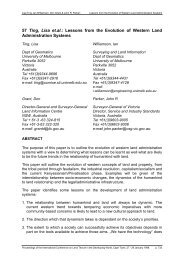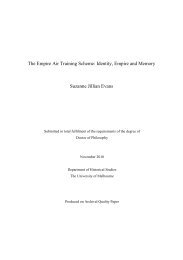Speculum - University of Melbourne
Speculum - University of Melbourne
Speculum - University of Melbourne
You also want an ePaper? Increase the reach of your titles
YUMPU automatically turns print PDFs into web optimized ePapers that Google loves.
12<br />
SPECULUM<br />
AN AFFAIR OF THE HEART<br />
M. L. Powell<br />
High upon the uppermost shelves <strong>of</strong> THE<br />
LIBRARY there rests in placid content<br />
Vol. XLVI <strong>of</strong> the Annals <strong>of</strong> Surgery which<br />
was published in the year 1907. On page<br />
335 is an article <strong>of</strong> rare prophecy. It is<br />
titled "Ligation <strong>of</strong> the Ductus Arteriosus"<br />
and is written by one John C. Munro M.D.,<br />
<strong>of</strong> Boston, Massachussetts, U.S.A. Though<br />
this paper was presented on May 6th, 1907,<br />
the idea was. born 19 years before — exactly<br />
55 years before Gross ligated the first ductus<br />
in, perhaps not strangely, Munro's home<br />
city <strong>of</strong> Boston.<br />
In 1888, Munro, who appears to have<br />
been surgically minded but with considerable<br />
medical interest, saw a girl baby (note<br />
that this first case was <strong>of</strong> the fair female sex<br />
which later was to prove three times more<br />
inept at closing that particular channel than<br />
the male) "with symptoms <strong>of</strong> some cardiac<br />
lesion. Ascultation at this time revealed<br />
a cardiac murmur with pulmonary rales but<br />
cyanosis was not• a marked feature. After<br />
death, which took place without oedema or<br />
marked cyanosis, examination showed an<br />
open ductus arteriosus lying easily within<br />
reach behind the sternum without any other<br />
defect except a dilated right ventricle". This<br />
in itself was a pr<strong>of</strong>ound observation for it<br />
is certain there have been many autopsies<br />
since that time, done in well equipped post<br />
mortem rooms in which the open ductus has<br />
not been found or certainly its significance<br />
missed as the cause <strong>of</strong> death.<br />
Munro found "the simplicity <strong>of</strong> the<br />
remedy so striking" that he made further<br />
dissections and felt it should be possible to<br />
ligate the duct during life if a diagnosis<br />
could be made. But in this his hopes seem<br />
to have been dimmed for his "paediatric<br />
advisers were not reassuring", but he urged<br />
"those skilled in the diagnosis <strong>of</strong> infantile<br />
lesions to lend their aid".<br />
Munro noted that cyanosis was wanting<br />
(as we now appreciate befits a left to right<br />
shunt) that an anaemia or waxy appearance<br />
is shown which well describes the pallor<br />
which is in fact <strong>of</strong>ten non-anaemic, but<br />
rather due to poor peripheral flow due to<br />
the shunt through the ductus, and that "a<br />
loud systolic whir conducted into the cervical<br />
vessels may be heard but, as a matter <strong>of</strong> fact<br />
there are no definite auscultatory signs established<br />
as yet". Here in this last observation,<br />
is indicated for the first time that<br />
wonderful diagnostic sign, the continuous<br />
or machinery murmur heard high in the left<br />
chest close to the sternum which actually<br />
had been described by Gibson <strong>of</strong> Scotland<br />
seven years earlier.<br />
This is the murmur which when all its<br />
facets are appreciated instruct the clinician<br />
in terms <strong>of</strong> certitude unusual in the game <strong>of</strong><br />
chance which we call diagnosis, that the<br />
Ductus Botalli is anachronistically open.<br />
This small arteriovenous communication<br />
usually about 15 m.m. long and 5 m.m. in<br />
diameter is a useful channel during the<br />
intrauterine sojourn when oxygen derived<br />
from the placenta, short circuits the nonfunctioning<br />
lungs, and is shunted to the<br />
systemic circulation, a process which is<br />
assisted by the hypertension <strong>of</strong> the foetal<br />
pulmonary circuit. With expansion <strong>of</strong> the<br />
lungs at birth the pulmonary arterial pressure<br />
falls and after about two weeks the<br />
ductus has closed.<br />
No clear cut answer has been provided<br />
to the question "Why does it close?". It<br />
is not unreasonable to suggest that at some<br />
time during the first two weeks <strong>of</strong> extra<br />
uterine life the pulmonary and systemic<br />
pressures are fairly well in balance and that<br />
there is little flow either way through the<br />
ductus for several days.<br />
Such stasis must conduce to contraction<br />
<strong>of</strong> the ductus, thrombus formation and<br />
ultimate obliteration. But it is not easy to<br />
suggest why on occasions it does not close<br />
and is thus responsible for a new branch <strong>of</strong>

















